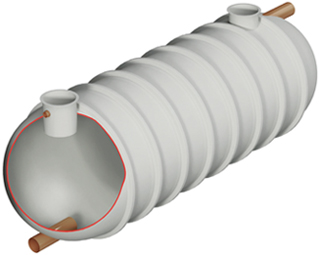We’ve discussed different aspects of septic tanks many times on this blog, but you may not be aware that there are in fact a number of different kinds of septic tanks that are used at domestic properties in the UK.
This month, the team at Wildon will be taking a look at the different septic tanks being used, together with a quick guide to their pros and cons.
Traditional septic tanks
Many older properties may still have a traditional septic tank made out of some combination of brick, concrete and stone. These usually have two chambers (although some will have three) and the waste flows laterally through the system. The waste enters the first tank where the heavier waste sinks to the bottom, while liquids feed into a second tank before being safely discharged into a drainage field.
Once installed, these tanks do last a long time – which is why there are quite a few still being used today – but you won’t find anyone putting new ones in anymore.
Onion Shape Septic Tank
Also sometimes known as an Alpha, these became popular after their introduction to the UK in the 1980s. They are usually manufactured out of glass reinforced plastic (GRP) and get their name because they are indeed shaped like an onion. Their main selling point is that they tend to be cheaper to buy than other options, but that initial saving comes at a price.
Because the flow in an onion shape septic tank is upwards rather than lateral, they are very big top to bottom – and that in turn means that when you come to install them, you have to dig a very deep hole. You also have to concrete them in once installed, so that means that while the initial purchase may be relatively cheap, installation is quite a lengthy business.
Bullet/shallow dig septic tank
Bullet, or shallow dig septic tanks – like the Klargester model available through Wildon – are like the old-fashioned brick septic tanks in that they operate laterally. Their big advantage over the onion shape tanks is that they are considerably easier and quicker to install. That’s because (and the clue is, again, in the name) you only have to dig a relatively shallow pit to house them and you don’t need to concrete them in afterwards.
Although the tanks themselves are fairly lightweight, many of them are manufactured with ribs around the body of the tank that make them very strong.
These are the main three septic tanks we come across, but you can also get tanks to go above ground. These are quick and easy to install, and unlike the others don’t need planning permission, but they are usually only intended to be a temporary solution.
For further information and advice on all things related to septic tanks, from their installation to regular maintenance, why not give the friendly team at Wildon a call today? We’re your local experts and have been managing the wastewater needs of customers around Stoke-on-Trent, Staffordshire and the rest of the UK for over 20 years.
Go back to








